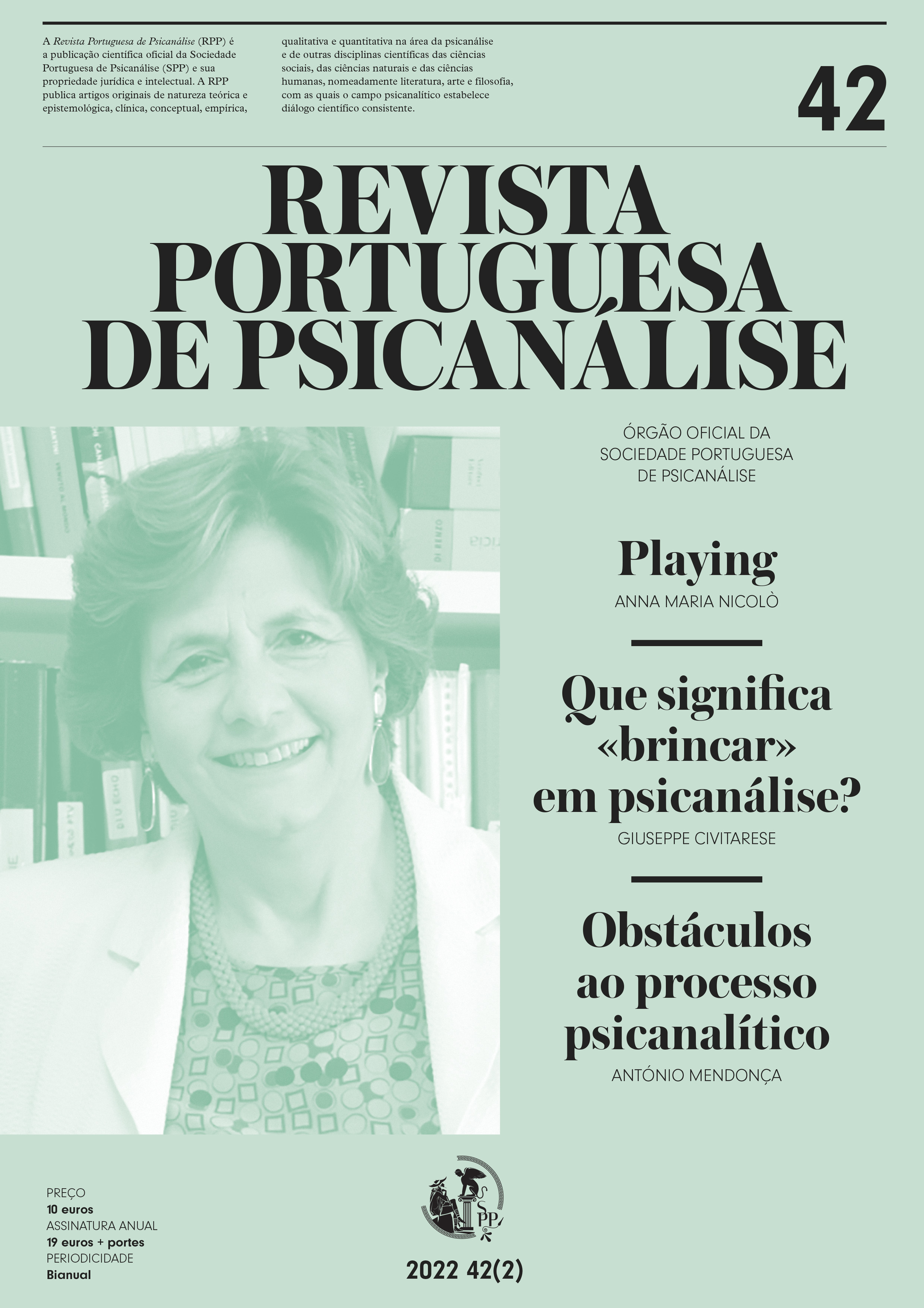O nosso sonho quando formos grandes é sermos capazes de brincar: Comentário ao artigo de Anna Maria Nicolò e de Giuseppe Civitarese sobre o signo do brincar em análise

Resumo
N/A
Palavras-chave
N/A
Biografia Autor
Conceição Melo Almeida
Psicóloga Clínica e Psicanalista de crianças adolescentes e adultos. Membro Titular da Sociedade Portuguesa de Psicanálise (SPP) e da Associação Psicanalítica Internacional (IPA).
Referências
- Baranger, W. & Baranger, M. (2008). The analytic situation as a dynamic field. The International Journal of Psychoanalysis, 89, 795–826. (Texto original publicado em 1961.)
- Bion,W. R. (1962). Learning From Experience. Basic Books.
- Bion, W. R. (1963). Elements of Psycho-Analysis. William Heinemann Medical Books Ltd. Bion, W.R. (1965). Transformations. William Heinemann Medical Books Ltd.
- Bion, W. R. (1991). A Memoir of the Future.
- Karnac Books. (Obra original publicada em 1975–1979.)
- Bleger, J. (1967). Psycho-analysis of the psycho-analytic frame. The International Journal of Psychoanalysis, 48, 511–519.
- Civitarese, G. (2014). Bion and the sublime: The origins of an aesthetic paradigm. The International Journal of Psychoanalysis, 95, 1059–1086.
- Civitarese, G. (2020). L’ora della nascita. Psicoanalisi del sublime e arte contemporanea. Jaca Book.
- Dias, A. C. (1996). Só Deus em mim se opõe a Deus. Um seminário de psicanálise. Fenda.
- Faimberg, H. (1996). ‘Listening to listening’. The International Journal of Psychoanalysis, 77(4), 667–677.
- Ferreira, B. R., & Almeida, C. M. (2021). A Conversation with Giuseppe Civitarese. Revista Portuguesa de Psicanálise, 41(2), 9–23. https://doi. org/10.51356/rpp.412a1
- Ferro, A. & Basile, R. (2009). The analytic field: a clinical concept. Karnac Books.
- Freud, S. (1920). Beyond the pleasure principle. Em The Standard Edition of the Complete Psychological Works of Sigmund Freud (vol. 18, pp. 1–64). Hogarth Press.
- Freud, S. (1964). Constructions in analysis. Em
- The Standard Edition of the Complete Psychological Works of Sigmund Freud,Volume XXIII (1937- 1939): Moses and Monotheism, An Outline of Psycho-Analysis and OtherWorks (pp. 255–270). (Obra original publicada em 1937.)
- Klein, M. (1929). Personification in the Play of Children. The International Journal of Psychoanalysis, 10, 193–204.
- Klein, M. (1932). The Psychoanalysis of Children. Hogarth.
- Langs, R. (1978). Some communicative properties of the bipersonal field. The International Journal of Psychoanalytic Psychotherapy, 7, 87–135.
- Levine, H. B. (2021). Trauma, process and representation, The International Journal of Psychoanalysis, 102, 794–807. https://doi.org/10. 1080/00207578.2020.1841923
- Levine, H. B. (2022). The Post-Bionian Field Theory of Antonino Ferro.Theoretical Analysis and Clinical Application. The Routledge Wilfred R. Bion Studies Book Series.
- Lewin, K. (1951). Field Theory in Social Science. Harper.
- Merleau-Ponty, M. (1945). Phénoménologie de la perception. Gallimard.
- Ogden,T. (1994).The analytic third: working with intersubjective clinical facts. The International Journal of Psychoanalysis, 75, 3–20.
- Ogden,T. H. (2014). Fear of breakdown and the unlived life. The International Journal of Psychoanalysis, 95(2), 205–223. https://doi. org/10.1111/1745-8315.12148
- Winnicott, D. W. (1953). Transitional objects and transitional phenomena. A study of the first not-me possession.The International Journal of Psychoanalysis, 34, 89–97.
- Winnicott, D.W. (1971). Playing and Reality. Basic Books.
- Winnicott, D. W. (1974). Fear of breakdown. International Review of Psycho-Analysis, 1(1–2), 103–107.